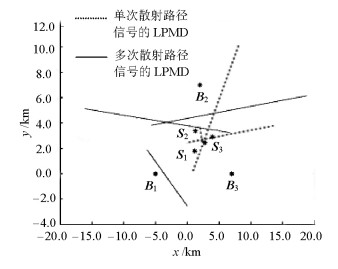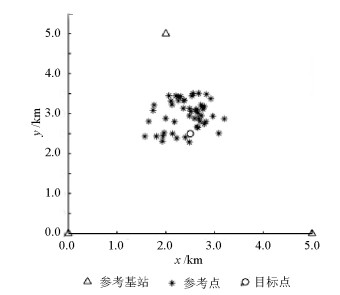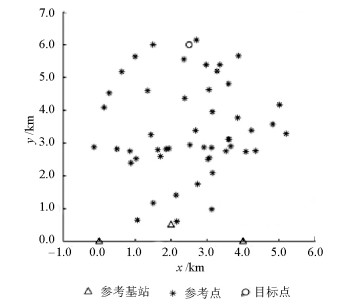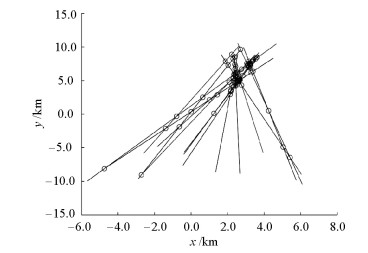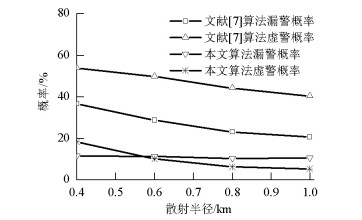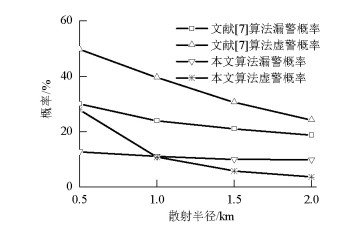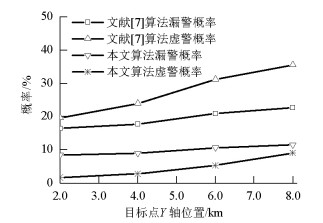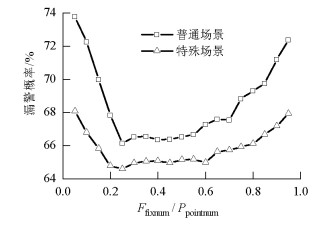Novel Scattering Path Recognition Algorithm Based on LPMD
-
摘要: NLOS(non-line-of-sight)非视距误差是地面无线定位的主要误差来源.为了从NLOS散射信号中识别出单次散射路径和多次散射路径,提出了一种新的基于LPMD(line-of-possible-mobile-device)目标可能位置线的识别算法.该算法以所有LPMD线的交点来计算初步参考点位置,并通过距离初步参考点较远的一部分交点对剩余较近的交点做负期望补偿,以修正参考点的位置,同时使用参考点到各LPMD线的直线距离来构造散射路径类型判决表达式,进行单/多次散射路径判决.在不同的仿真参数条件下,分别对普通场景和特殊场景进行了散射路径识别仿真实验,结果表明,当侦测站和目标点之间的距离达到4 km时,本文算法的虚警和漏警概率分别只有3%和9%,比原有基于LPMD算法的分别降低了21%和8%.Abstract: Non-line-of-sight (NLOS) error is the major source of error in ground wireless localization. In order to recognize single-bound scattering path and multiple-bound scattering paths from all the NLOS scattering paths, we propose a novel recognition algorithm based on line-of-possible-mobile-device (LPMD). This algorithm first utilizes the cross points of all the LPMDs to calculate the coordinate of a reference point. The algorithm then uses part of the cross points far away from the reference point to obtain minus expectation compensation to revise the location of reference point, builds the judgement formula of scatter path type based on the distance between each LPMD and the reference point to make single/multiple bound path judgement. Under normal and special scenery, the simulation tests of scatter path judgement are performed under different parameter conditions; the simulation results show when the distance between the target and the detecting station reaches 4 km. A false alarm probability and a false dismissal probability of the proposed algorithm can be limited to 3%and 9%, respectively. Further, these probabilities can be decreased by about 21% and 8%, respectively, when compared with the original LPMD algorithm..
-
表 1 普通场景下两种算法的参考点平均偏差
Table 1. Average deviation between refer-point and real target of both algorithms under normal scene
算法 参考点平均偏差/m 文献[7] 726.3 本文 74.7 表 2 特殊场景下两种算法的参考点平均偏差
Table 2. Average deviation between refer-point and real target of both algorithms under special scene
算法 参考点平均偏差/m 文献[7] 2741.3 本文 191.5 -
JATIVA E R, SANCHEZ D, VIDAL J. NLOS mitigation based on TOA for mobile subscriber positioning systems by weighting measures and geometrical restrictions[C]//2015 Asia-Pacific Conference on Computer Aided System Engineering (APCASE).[S.l.]: IEEE, 2015: 325-330. SILVENTOINEN M I, RANTALAINEN T. Mobile station emergency locating in GSM[C]//IEEE International Conference on Personal Wireless Communications.[S.l.]: IEEE Xplore, 1996: 232-238. 周非, 陈庭盈, 范馨月.基于AOA-TOA重构的单站定位算法[J].重庆邮电大学学报, 2012, 24(2):222-226. http://d.old.wanfangdata.com.cn/Periodical/cqydxyxb-zrkx201202019ZHOU Fei, CHEN Tingying, FAN Xinyue. Algorithm of single station location based on AOA-TOA reconstruction[J]. Journal of Chongqing University of Posts & Telecommunications, 2012, 24(2):222-226. http://d.old.wanfangdata.com.cn/Periodical/cqydxyxb-zrkx201202019 TIAN Z, YAO L, ZHOU M, et al. Scattering model based hybrid TOA/AOA/AOD localization in NLOS environment[C]//The Proceedings of the Second International Conference on Communications, Signal Processing, and Systems.[S.l.]: Springer International Publishing, 2014: 893-901. LIBERTI J C, RAPPAPORT T S. A geometrically based model for line-of-sight multipath radio channels[C]//Vehicular Technology Conference on Mobile Technology for the Human Race.[S.l.]: IEEE, 1996: 844-848. SIMSIM M T, KHAN N M, RAMER R, et al. Time of arrival statistics in cellular environments[C]//Proceedings of the 64th IEEE Vehicular Technology Conference.[S.l.]: IEEE, 2006: 2666-2670. SEOW C K, TAN S Y. Non-line-of-sight localization in multipath environments[J]. IEEE Transactions on Moblie Computing, 2008, 7(5):647-660. doi: 10.1109/TMC.2007.70780 杨天池, 程娟, 邵奇峰, 等.单站定位中的散射体位置及散射距离的估计方法:合成运动的扩展卡尔曼估计[J].电子学报, 2014, 42(4):730-735. doi: 10.3969/j.issn.0372-2112.2014.04.017YANF Tianchi, CHENG Juan, SHAO Qifeng, et al. The estimation of the scatterer position and scattering distance in the single station location:the EKF estimation based on synthetic motion[J]. Acta Electronica Sinica, 2014, 42(4):730-735. doi: 10.3969/j.issn.0372-2112.2014.04.017 ZHOU F, FAN X, CHEN T Y. Improved positioning algorithm based on linear constraints on scatterers[J]. EURASIP Journal on Wireless Communications and Networking, 2013, 2013(1):1-10. doi: 10.1186/1687-1499-2013-1 CHEN S W, SEOW C K, TAN S Y. Virtual reference device-based NLOS localization in multipath environment[J]. IEEE Antennas and Wireless Propagation Letters, 2014, 13(13):1409-1412. http://ieeexplore.ieee.org/document/6858043/ ZHU X, SHI M, ZHANG J, et al. A scattering model based non-line-of-sight error mitigating algorithm via distributed multi-antenna[C]//IEEE 18th International Symposium on Personal, Indoor and Mobile Radio Communications.[S.l.]: IEEE Xplore, 2007: 1-5. AL-JAZZAR S, GHOGHO M, MCLERNON D. A joint TOA/AOA constrained minimization method for locating wireless devices in non-line-of-sight environment[J]. IEEE Transactions on Vehicular Technology, 2009, 58(1):468-472. doi: 10.1109/TVT.2008.923670 肖竹, 陈杰, 王东, 等.严重遮挡非视距环境下的三维定位方法[J].通信学报, 2015, 36(8):68-75. http://d.old.wanfangdata.com.cn/Periodical/txxb201508009XIAO Zhu, CHEN Jie, WANG Dong, et al. Three-dimensional localization under severely obstructed NLOS environment[J]. Journal on Communications, 2015, 36(8):68-75. http://d.old.wanfangdata.com.cn/Periodical/txxb201508009 MIAO H, YU K, JUNTTI M J. Positioning for NLOS propagation:algorithm derivations and cramer-rao bounds[J]. IEEE Transactions on Vehicular Technology, 2007, 56(5):2568-2580. doi: 10.1109/TVT.2007.899948 OLENKO A Y, WONG K T, NG H O. Analytically derived TOA-DOA statistics of uplink/downlink wireless multipaths arisen from scatterers on a hollow-disc around the mobile[J]. IEEE Antennas and Wireless Propagation Letters, 2003, 2(1):345-348. http://www.wanfangdata.com.cn/details/detail.do?_type=perio&id=61e290d01d3b01bec3b9e16106bd06f5 -





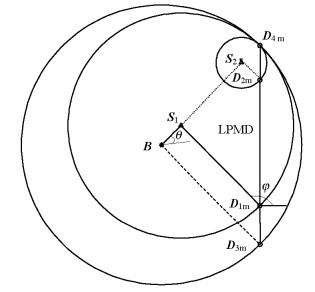
 下载:
下载:
